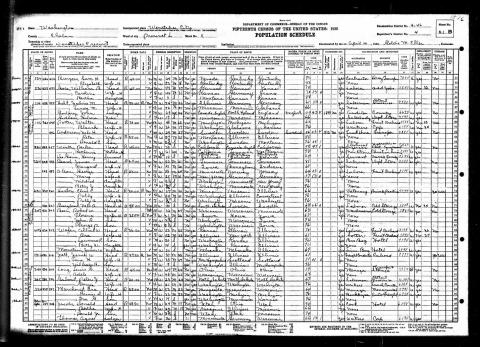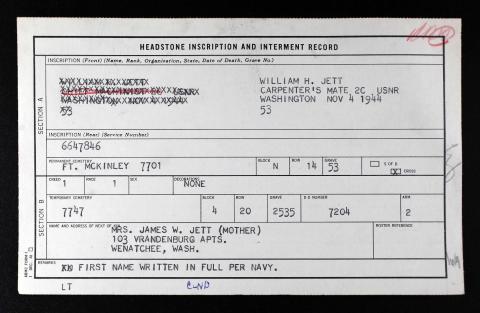William Hodge Jett
Pre-WSC Background
William Hodge Jett was born on September 23, 1920, in Spokane, Washington. He was the first and only son of his parents, James and Lena Jett. Jett’s parents originated from Illinois and New Hampshire, respectively, moving to Washington before their son was born. While Jett was born in Spokane, the couple soon moved to Wenatchee before the 1930 Census was taken. For the census, James listed that he was employed on the railroad as a freight conductor. Now settled in Wenatchee, William attended grade school in town and eventually got to Wenatchee High School for his final years in town. Jett graduated from WHS in 1938, contrary to an erroneous report in a later newspaper stated he graduated in 1941. After this, Jett looked east to Washington State College for the next phase of his life, enrolling for the fall of 1938.
WSC Experience
Jett’s brief time at WSC was not uncommon for many students, as leaving college after a single year was something that many did. The reasons for this vary greatly, perhaps college did not offer what they were looking for or the cost was too great. Nevertheless, Jett majored in Mechanical Engineering during his single year, foreshadowing his future role in the military. Spending one year at WSC did not allow Jett to involve himself in many activities or clubs, but he still managed to find his way into the 1939 annual yearbook. Jett was listed as part of the Montezuma Club, which was likely a social club on campus. After his second semester concluded in spring 1939, Jett departed from Pullman and returned to Wenatchee to try a different path in life. In the 1940 Census, Jett reports to be living with his parents once more and working as a garageman at a service station to make a living. Life seemed to have returned to some consistency as Jett worked, but the outbreak of war in December 1941 changed the course of his life. With war now raging, many young American men felt the call to serve their country and this call was no different for Jett. In August 1942, Jett enlisted for service in the US Navy. This was the start of a journey that took him across the Pacific Ocean in service to the nation.
Wartime Service and Death
The military career of William Jett is different to many other WSC veterans as he served in a unique branch of the US Navy. It is unknown where he completed his training but once completed, Jett became a part of the Navy Seabees. The Seabees are described as “construction workers fully trained in defending themselves against enemy attack while building the infrastructure to keep the war effort moving.” World War II necessitated a strong fighting force as well as a corps of men who had the mission of building camps, headquarters, and other structures. In the Pacific Theater, this ability was especially needed in remote island outposts that lacked sufficient buildings. After enlisting, Jett was assigned to the 38th Construction Battalion and was with the unit when they departed for action in January 1943. The 38th was a very new unit, being commissioned in November 1942 at Camp Allen, Virginia. After completing their initial training, the battalion moved to Camp Bradford, Virginia for advanced training before sailing out and arriving on the Aleutian Islands in January. It was on this isolated chain of islands that the 38th and the Seabees were put to the test.
The Aleutian Islands, located southwest of the Alaska Peninsula, were invaded by Japanese forces in June 1942 and held well into 1943. Despite holding little strategic value, retaking American land was a priority for the United States. Being in such a remote, underdeveloped location posed an issue for the military as over 100,000 American troops were based in Alaska, requiring the building of thirteen new bases. The construction did not come easily, as the rough Alaskan weather and environment proved to be arduous, causing most of the American casualties during the campaign. The primary islands held by Japan were Attu and Kiska, occupied by thousands of Japanese troops that were difficult to dislodge. In May 1943, American forces landed on Attu and fought the Japanese in ferocious battles and in harsh weather. Though the Japanese proved hardy on Attu, the Kiska invasion was drastically different. When 35,000 American and Canadian troops landed on Kiska in mid-August, they discovered no Japanese as they had evacuated before the battle. After successfully helping take back the Aleutians, the men of the 38th returned back to the US after over a year on the islands. Now stationed in Camp Parks, California, the battalion rested and waited for a new assignment. After making it through the tough campaign, Jett reached the rank of Carpenter’s Mate Second Class as a Seabee. Though the 38th participated in other construction projects during the war, Jett’s time with the unit was coming to an end.
Very little documentation on Jett’s military career exists and what little there is does not answer the many questions left behind. Despite being attached to the 38th for well over a year, all documents regarding Jett’s death claim that he was killed in action on Peleliu Island, an island that the 38th never reported being on. The Battle of Peleliu began on August 15, 1944, as US Marines landed on the island and immediately encountered hard Japanese resistance in the scorching heat. The Japanese prepared well, holding out for months while American casualties mounted. After months of savage combat, Peleliu was declared secure on November 27. Why or how Jett ended up on Peleliu is a mystery, as no documents mention a transfer from the 38th, and news coverage of his death speaks about his service in the Aleutians before his death on the island. Among the thousands of casualties was William Jett, listed as killed in action on November 4. He was likely buried on Peleliu initially but was moved to the Ft. McKinley Cemetery in the Philippines for permanent burial. Jett was twenty-four years old at the time of his death. His name is listed on the WSU Veterans Memorial along with every WSC student who perished during World War II.
Postwar Legacy
The military service of William Jett stands out amongst the many WSC veterans that served during World War II. He played a key role in the success of the Aleutian Campaign, showing that service to his country could be done without a rifle. Jett and the Seabees were unsung heroes that made offensives into the Pacific possible by providing the infrastructure necessary to win the war.




